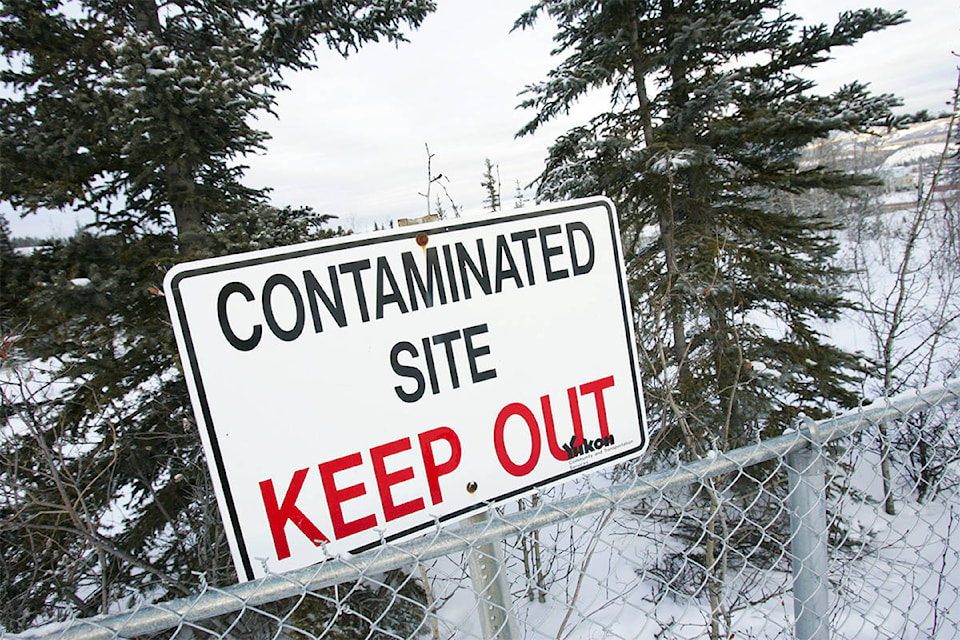Remediation work at the Marwell tar pit is set to start this summer, years later than it was originally supposed to.
The project’s manager said technology being used to remove the hydrocarbons is expected to mean more contamination can be taken out of the soil.
“The site has been long in need of attention and we have budgeted $4.6 million toward environmental cleanup of the site. The Government of Canada has contributed 70 per cent of the cost of this project, and we appreciate their assistance in getting this remediation underway,” Yukon Environment Minister Pauline Frost told the legislative assembly March 14.
The total budget for the cleanup is $6.8 million.
According to investigations done in the 1990s, hydrocarbons have contaminated an estimated 27,000 cubic meters of soil as well as the groundwater.
The mess was caused by an oil refinery built in the area during the Second World War. The refinery operated for less than a year before closing in March 1945.
It was dismantled and shipped south. The sludge from the bottom of storage tanks — or tar — was deposited in a tank berm.
“For many years, Whitehorse businesses and individuals added used oil and other liquid wastes to the tar pit,” says a history of the site on Environment Yukon’s website.
“In the early 1960s, the gooey pit was capped with gravel. The Government of Yukon declared the tar pit a designated contaminated site in 1998 under the Environment Act.”
When the ground is warm enough this summer, crews will start excavating the dirty soil.
It will be placed in a greenhouse-style building. The soil is heated by pipes to vaporize the hydrocarbons. The vapours will then be burnt off “similar to a propane torch,” said project manager Rick Seaman.
The remediation is expected to take two years, though Seaman said it may be able to be done more quickly.
Similar methods have been used elsewhere for decades, he said, but this is only the second time something like this has been used in the Yukon.
A passive system like this one is cheaper and require less labour than others, Seaman said. He suspects the government will now be able to clean up more of the site with its budget than was originally planned.
“Initially we had hoped we could clean up about 50 per cent of the site. With the approach we’re looking at, and my discussions with the contractor, the number I’m using now is 65 to 85 per cent of the site.”
Seaman said crews typically don’t get all of the contamination.
“Generally you get the worst of it, you get the source … and then you risk-manage the rest of the site to make sure that it’s not impacting the neighbours or anything else.”
Planning work, as well as getting the project through the environmental assessment process wrapped up in 2015.
Phase three, after the remediation is complete, will involve installing monitoring wells, he said.
A funding deal with the federal government was signed in 2010. At the time, the whole project was supposed to take 10 years.
The original timeline had the remediation work happening in 2015-16 and 2016-17, Seaman said. But the federal funding was deferred until now by both the former Yukon Party and the current Liberal governments.
Seaman said he wasn’t privy to why those decisions were made.
“What we do know is that the previous government approved and agreed to the YESAB recommendation in October 2015 and did nothing for a year,” NDP Leader Liz Hanson said in the legislative assembly following Frost’s statement.
“This government has been aware of that decision since November 2016 when it was elected and has chosen today to make the announcement, 16 months later, to announce that it is finally going to act on the YESAB recommendation.”
Yukon Party chief of staff Ted Laking said the former government wanted to make sure the work was done in a way that would benefit local contractors.
“As the government has noted, this is seasonally-dependent work and unfortunately we were unable to get to the next phase of remediation prior to the election,” Laking said in an email.
“Had we been re-elected we had the full intention of moving it forward and are happy to see this government continue this work.”
Meanwhile the Liberals are blaming the previous government.
Since the Yukon Party deferred funding “it took some time to get planning and approvals in place to embark on this work,” cabinet spokesperson Janine Workman said in an email. “We are pleased to have a contract out the door to see remediation on this long overdue project begin.”
The Yukon was granted an extension on its funding agreement with Ottawa. The deal, which was supposed to end in 2020-21 will now go to March 31, 2024.
Lewis Rifkind of the Yukon Conservation Society said he’s glad the remediation work is “finally” happening.
He said he wouldn’t be surprised if the project takes longer and costs more than expected.
“Every time you start messing around with these old, toxic dump sites, you think you know what’s there … who knows what they’re going to stir up or find.”
Seaman said the plan is to clean up the land to a commercial/industrial standard, “which would then potentially make the land available for other uses.”
Contact Ashley Joannou at ashleyj@yukon-news.com
